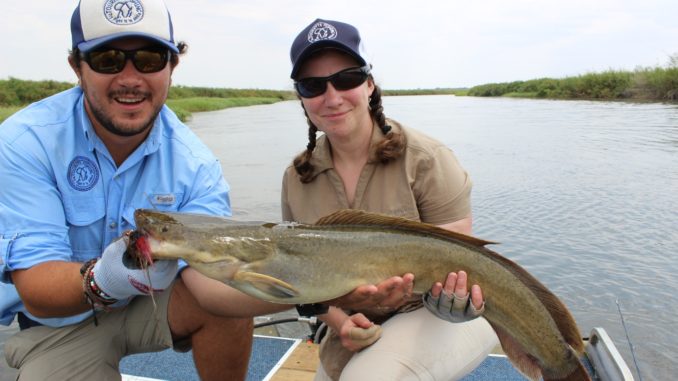
People who love catfishing have their own preference when it comes to bait, and each catfisher swears by it. Did you know that a catfish can taste and even smell the difference between bait? Catfish can be very particular. Living in still water they’re more active and take their time choosing their food. They are also able to disregard most smells and bait in their very active environment. The best catfish bait should capture their attention. The right type of bait can make all the difference when it comes to your success out on the water.
Options for the Best Catfish Bait
There is a big debate when it comes to using cut sections of bait or live bait. Certain types of catfish, such as the flathead, prefer live bait. However, using prepared baits such as doughs or chunks offer more convenience and also reduces waste.
Catfish are fed based on the taste and smell of the bait, which is why the best catfish bait needs to be appealing to these fish. Currently, it’s unknown exactly how many species of catfish there are. Experts have discovered 3,000, but believe there could be as many as 4,500. Each species will have their own food preferences. They can also be finicky eaters, so don’t expect the same type of bait to work every time. With this in mind, it’s wise to bring a long a few different types of the best catfish bait, and allow the fish to choose.
There are dozens of different types of bait to choose from, ranging from raw bacon to live crawdads. While there may be many options for catfish bait, there are certain baits that tend to stand out from the rest.
Shad and Chicken Livers for Catfish Bait
The size of a catfish will also play a role when it comes to choosing the best bait for catfish. A large catfish will need a large meal. Using cut or live shad can definitely improve your chances of landing a true trophy cat. Even the catfish that live in channels will rely heavily on eating other smaller fish, once they are about eight to ten pounds. Using shad as your bait is a great option because they’re prevalent in most rivers and reservoirs, which makes them readily available to fishermen. Experts recommend cutting bait shad into strips or chunks. The size of these chunks or strips should be based on the size of the catfish in the area. The most efficient way to cut up this bait is to slice of the tail and head, cutting across the body in strips. The shad’s entrails produce a very potent smell, which works to attract catfish immediately. Shad entrails don’t make a good large meal, so instead use them initially as a way to attract catfish and plan on tossing in the cut up strips or chunks once you’ve attracted a crowd.
For certain species of catfish the shad will need to be alive and should be the size of your palm. The bait should be presented near the bottom of thick cover. Usually, in rivers catfish will hangout around the outside bends, hidden in thick brush or tree branches around the river bank. In a reservoir, catfish can usually be found along the bends in a creek channel.
Chicken livers are one of the most commonly used bait for catfish. This is because they produce a very strong meaty smell, which makes them almost irresistible to catfish. Chicken livers don’t usually attract large fish, but the livers can attract ten pounders. This type of bait is also pretty inexpensive and easy to find at any grocery store. Initially, the livers can be hard to keep on the hook, but should toughen up once they’ve been in the water for about five minutes. After being on the hook for twenty to thirty minutes the liver loses its appeal because they lose their natural juices.
Why Catfish Love Dip and Night Crawlers
Some fishermen make their own dips, using old recipes that have been in their family for generations. Other fisherman swear by commercial blends that can be purchased by the case. A dip is actually a gooey mixture that typically smells dreadfully potent, which makes it irresistible to catfish. While these dips smell horrible, a bad odor isn’t all it takes to bring in bigger fish. These dips should feature a cheese base or heavy protein content. The consistency of the dip is also important. It should be solid enough that it won’t immediately wash away, but soft enough that it breaks apart gradually. This type of bait works best in bodies of water with a current, because the moving water will carry some of the bait particles downstream, creating a chum line.
Night crawlers are also an excellent choice for catfish bait, and the bigger the crawler, the better. Experts recommend using a few worms on your hook at a time. When using worms, suspend them beneath a float, allowing the bait to hang barely off the bottom. This works the best for fish that are hiding around the bases of trees or beneath thick brush along river banks. Using a float allows you to have more control over where the bait is presented and can easily be relocated once you spot hidden catfish. And because this type of bait doesn’t need to be cut up, there’s no mess to deal with. Also, if you’ve given up and would like to enlist in maid cleaning services, you should check out the link prior, do your research, and look into professional cleaning that can get the job done for you!
If you are getting cold while being outside fishing for catfish, you should check out the top rated outdoor blankets by clicking here. Why sit in the cold when you can research what works best for your needs to keep you warm at all times when you are in the great outdoors. Do some research and let us know what you think!
—————
Author Bio
Richard Clayton
I’m an owner of a small gardening shop and a lawn care blog. I love gardening, especially lawn care. I can spend all of my free time taking care of my lawn and discuss about lawn care experiences with my friends, who have the same hobby as me. My website is a playground of us, where we can discuss everything about lawn care techniques.






